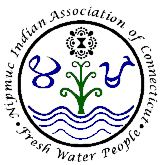 THE
THE
Nipmuc Indian Association of Connecticut
Historical Series - Number 2
Second Edition 1995
|
BACKGROUND
In 1646, Reverend John Eliot first preached to Indians at a site he later called Nonantum ('Place of Rejoicing') in present-day Newton, MA. Making converts to Christianity there, Eliot became encouraged by the possibility of gradual religious, social and political integration of all Indians into colonial society. Eliot continued his efforts to convert Indians, becoming known as the 'Indian Apostle'.
Waban (at Natick, MA) was the first Indian chief to embrace Christianity, and entertained John Eliot in his wigwam when Eliot first went among the Nipmuc as a preacher in their own language on October 28, 1648. By 1650, Indian converts to Christianity had begun moving to Natick to organize what would become the first of several villages known as "Praying Towns", with the Indians in them known as "Praying Indians". Here, as in all of the Praying Towns which followed, Indians would renounce their native language, ceremonies, beliefs, traditional dress and customs -- effectively becoming 'Red' Puritans. Natick was also the place where young educated Indian men would be trained as missionaries and sent out to convert more Indians and to establish additional Praying Towns.
John Eliot's Rules of Conduct for the Praying Indians (eight additions to the Decalogue) were as follows:
By about 1660, Eliot had seen seven new Praying Towns established in Nipmuc territory, including three which existed in present-day Windham County, Connecticut. In his Report to the Governor and Council Concerning the Indians of the Commonwealth (Boston, 1861.), John Milton Earle states: "These Indians were visited in July, 1663, by the Apostle Eliot, accompanied by Hon. Daniel Gookin, who informs us, that "the seven new praying towns, in the Nipmug country, under the jurisdiction of Massachusetts, began to harken to the gospel about three years since, or thereabouts." They were visited again in September, 1674, for the purpose of settling teachers and establishing civil government among them. The following three Praying Towns, all of which were located in present-day northeastern Connecticut, are listed among the seven visited.
THE "PRAYING TOWNS" OF NORTHEASTERN CONNECTICUT
MAANEXIT - Located on the Quinebaug River near the old Connecticut Path to and from Massachusetts, the Praying Town called Maanexit held 100 Nipmuc men, women and children. The Indian John Moqua was installed as minister at Maanexit in September, 1674. Maanexit is believed to have been located in present-day Fabyan, in the Town of Thompson.
Maanexit (also spelled Mayanexit) is a Nipmuc word meaning either "where the road lies" or "where we gather", depending on what the proper root word was.
QUINNATISSET - The Praying Town called Quinnatisset was located about "6 miles south of Maanexit" (on Thompson Hill, near the center of the town?). It, too, held 100 Nipmuc people. Daniel, a young Indian schooled at Natick, was installed as minister for Quinnatisset in 1674.
Quinnatisset, another Nipmuc word, means "little long river" or "long brook".
WABAQUASSET - The largest of the three northeastern Connecticut Praying Towns, Wabaquasset held 150 people from 30 Nipmuc families. It was located 6 miles west of the Quinebaug River in present-day Woodstock. Sampson and Joseph (only sons of Petuhanit, sachem of Hassanamesit - now Grafton, MA) came to Wabaquasset as Christian missionaries and preached throughout the area for four years. Sampson lived at Wabaquasset and, under his direction, wigwams were built "the like of which were seen in no other part of the country". It is reported that the longhouse there measured 60' long by 20' wide; and a ripening crop of corn there in 1674 would yield no less than 40 bushels to an acre!
John Eliot (in Mass. Arch., Indians, i. 146) spelled the name of this Praying Town Wabuhquoshish, a Nipmuc word meaning at the place where we make "mats for covering the house". The name originally belonged to a certain place where Nipmuc women obtained flags used to weave mats.
WHERE DID THEY G0?
The start of King Philip's War on June 20, 1675 -- initiated by Pometacom, Great Sachem of the Wampanoag Federation -- marked the demise of the Praying Towns in northeastern Connecticut. Anti-Indian sentiment raged throughout central New England. Nipmuc elders, women and children may have fled to safety in the Praying Town at Okommakamesit or with other tribes; or, they may have been among the nearly 400 Indians (whose able-bodied men were drawn into the war) who were left on Long Island to suffer from lack of adequate food and shelter.
The Nipmuc brothers Sampson and Joseph, who had spent some 4 years preaching and organizing. Praying Indians in northeastern Connecticut, became scouts for the English. They received a certificate from English Captain Thomas Wheeler on August 20, 1675 commending them for their courage and faithfulness.
But Sampson was slain during the War. And Joseph was taken prisoner in Plymouth Colony, MA, sold for a slave to some merchants at Boston, and sent to Jamaica. His two children were taken prisoner with him, and his wife was taken captive. John Eliot later redeemed Joseph's wife and sons. Eliot also intervened and had Joseph brought back to Massachusetts; but Joseph was still held as a slave.
|